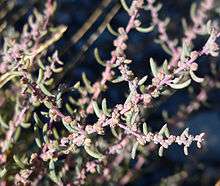Suaeda nigra
| Suaeda nigra | |
|---|---|
 | |
| Scientific classification | |
| Kingdom: | Plantae |
| (unranked): | Angiosperms |
| (unranked): | Eudicots |
| (unranked): | Core eudicots |
| Order: | Caryophyllales |
| Family: | Amaranthaceae |
| Subfamily: | Suaedoideae |
| Genus: | Suaeda |
| Species: | S. nigra |
| Binomial name | |
| Suaeda nigra (Raf.) J.F.Macbr. | |
| Synonyms | |
| |
Suaeda nigra (formerly Suaeda moquinii)[1] is a species of flowering plant in the amaranth family known by the common names Mojave sea-blite[2] and bush seepweed.
Distribution
Suaeda nigra is native to much of western North America, from central Canada through the Western United States, Great Basin, the Mojave Desert in California, and into northern Mexico. It grows in many types of habitat with saline and alkaline substrates, such as desert flats, playas, and seeps.
It is mostly an inland species but is occasionally seen in coastal areas, such as estuaries.[3]
Description
Suaeda nigra is a shrub or subshrub growing from a woody base with many spreading branches, reaching up to 1.5 metres (4.9 ft) in height. The plants may grow as annuals at times.
The species is genetically diverse and quite variable in appearance.[1] It may be hairy to hairless but is usually waxy. It may be green to red to dark purple in color, sometimes almost black. The fleshy leaves are linear to lance-shaped, 1 to 3 centimeters long, and flat or cylindrical.
Flowers occur in clusters along the upper stems, each cluster containing 1 to 12 flowers. Leaflike bracts accompany the clusters. The flower has no petals and is composed of a calyx of fleshy, rounded sepals.
The fruit is an utricle that grows within the calyx.
References
- 1 2 Flora of North America
- ↑ "Suaeda moquinii". Natural Resources Conservation Service PLANTS Database. USDA. Retrieved 4 December 2015.
- ↑ Jepson
External links
| Wikimedia Commons has media related to Suaeda nigra. |